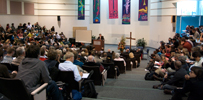Coronavirus and the Communion of the Saints

"the pestilence that walketh in darkness”
—Psalm 91: 6
At the beginning of June, Carolyn and I were supposed to be leading a travel course for Regent College in Italy, “Martyrs, Monks, and Mystics,” but we sent a note to all the participants in mid-March to cancel because of the coronavirus. This seemed a judgment call at the time, but within days it became clear that it was the right decision: Europe went into lockdown and the grim statistics of the growing number of dead were reported each evening.
As a historian, it has given me pause. I remember that we have been here before.
It is as though the clock has been turned back several centuries. I was struck by the comment in the Financial Times of the famous virologist Peter Piot (who discovered Ebola): “All we have is medieval ways of containment: isolation, quarantine, contact tracing.” We have gone back in time.
Gregory the Great in Early Medieval Rome
As we were canceling our Italy trip, I was reminded of the early medieval bishop of Rome, Gregory the Great. He was called to lead in the hardest of times. We were hoping to park the tour bus by his family estate at the present church of San Gregorio Magno al Celio before we left Rome for Assisi. We would have told everyone that from his home on the Caelian hill, he could literally have looked straight across the little valley (as we can today) to the Palatine hill to see the crumbling palaces of past Roman emperors. To Gregory’s right was the already decaying Colosseum and ruins of the Forum. Repeated sieges of Rome had left famine and disease in their wake. Large areas of the city were destroyed by fire, and civil society stopped functioning altogether.
And that is not all: plague was pandemic during Gregory’s whole adult life. Something like a third of the population was wiped out during these years by their version of the coronavirus.
In this situation, what did Gregory do? He served his generation. He fed the poor, clothed the naked, and ministered to the sick. He devoted himself to prayer, supported the new Benedictine communities, sent out missionaries, promoted high standards for pastoral care, and took over the running of the city.
The pressures of his life meant that he could write eloquently of what it was to balance a life of active service with a life of prayer. He found inspiration from the example of the ministry of Christ himself.
He said, “The active life is to give bread to the hungry, to teach the ignorant the word of wisdom, to correct the erring . . . to tend to the sick, to dispense to all what they need, and to provide those entrusted to us with the means of subsistence.” Yet, even still, one was also to pray fervently: The contemplative life is “to cleave only to the desire of the Maker.” The soul is always to be “aglow to see the face of its Creator.”
Some of the collects in the Anglican Prayer Book today go back to Gregory and to a service book called the “Gregorian Sacramentary.” These prayers reflect the insecure times in which he lived. We can still pray with Gregory:
O God, the protector of all that trust in thee, without whom nothing is strong, nothing is holy: Increase and multiply upon us thy mercy; that, thou being our ruler and guide, we may so pass through things temporal, that we finally lose not the things eternal: Grant this, O heavenly Father, for Jesus Christ's sake our Lord. Amen. (Trinity 4)
Francis of Assisi and Father Damien
When Carolyn and I wrote to cancel our Italy course we were in Britain, just outside Oxford, where I had planned to spend two months doing research. But events here have overtaken us as well, and we had to scramble to fly home to Vancouver before the borders close and flights are cancelled. I am writing this now from an airplane somewhere over Greenland. The flight is full and people are scared. When we land in Vancouver, we will begin fourteen days in isolation to make sure we are not carrying the virus. It is an insecure time.
Had we made it to Assisi in June with our travel course, I would have spoken of St. Francis’s love for those who had leprosy (another contagious disease) in the thirteenth century. In the Upper Church of San Francesco, under Giotto’s frescos of the life of Francis, I would have told of how he overcame his revulsion, embracing those who were quarantined from society and left destitute. Because Jesus became poor and outcast for our sakes, Francis saw each leper as an icon of Christ crucified.
We would have visited the church of San Damiano, where Francis began his vocation and gathered a community. It was where an Italo-Byzantine painting of the crucifixion spoke to him deeply of the condescension of God. This painting of Christ in pity is still in Assisi, now at the church of Santa Chiara in the upper town.
A church named after “San Damiano” (a fourth-century physician who took no money) makes me think of the saint’s namesake, Father Damien. He was a nineteenth-century Belgian priest who followed in Francis’s steps, living his life with the lepers. These lepers were quarantined on an isolated caldera at the base of two-thousand foot cliffs on the Hawaiian island of Molokai. Hawaiians were particularly susceptible to leprosy (known as Hansen’s disease now), and when they were diagnosed, they were declared legally dead and transported to Molokai, dropped overboard if necessary, and left to swim for shore. Carolyn and I were there a few years ago and were moved by the story of this priest who gave his life to bring love where there was no love. He built houses and he built community. We walked among the ruins of the buildings and sat in his church—this place of so much sadness and so much love.
Pandemics in the Early Church
This Christian instinct to care for those who suffer from communicable disease and all its devastating physical, social, and economic consequences runs deep in the history of the church. The sociologist Rodney Stark, in his Rise of Christianity, has argued that the success of Christianity in the early centuries was in large part because of its ethic of care, not least in times of plague.
There was a severe plague in the Roman empire in the mid-third century. In North Africa, bishop Cyprian wrote about how this tested the humanity of all, “whether the well care for the sick, whether relatives dutifully love their kinsmen as they should, whether masters show compassion for their ailing slaves, whether physicians do not desert the afflicted.” Above all, Christians could show their neighbours that they did not fear death.
This was the same further to the east in Alexandria in Egypt (where today virus is again spreading). The bishop wrote in his Easter letter in 260 that “most of our brother Christians showed unbounded love and loyalty, never sparing themselves and thinking only of one another. Heedless of danger, they took charge of the sick, attending to their every need and ministering to them in Christ.” This was a costly business, “for they were infected by others with the disease, drawing on themselves the sickness of their neighbours.” The bishop knew how this ended: “Many, in nursing and curing others, transferred death to themselves and died in their stead.... The best of our brothers lost their lives in this manner.”
Jail Distemper in 18th-Century London
In my own research, I was moved by a similar ethic displayed by ordinary lay Christians in the eighteenth century. Sarah Peters was a model lay Methodist who would visit the sick, relieve the poor, and visit condemned criminals. It was at her instigation that a Methodist schoolmaster, Silas Told, began a thirty-five-year ministry of visiting those on their way to the gallows. They would sometimes lock themselves in with the prisoners overnight.
One night, Peters informed Told of ten criminals condemned to death in London and invited him to go with her to pray with them. They did so on Sunday, October 9, 1748. They met a one-time Methodist convicted for burglary, and spent time in his cell even though a “jail-distemper” and “pestilential fever” was raging. Six or seven other prisoners came along. They sang, read Scripture, prayed, and all were in tears. Before the execution there was an all-night prayer meeting and prison revival. John Wesley ends his account of all this with the death of Sarah Peters, since she died some ten days later of a malignant fever, caught while visiting the prison. Her solidarity with the condemned and diseased made her, in her own way, a martyr.
The strange thing about this new communicable disease today, however, is that the Christian instinct to care for the suffering and embrace the outcast means, at least initially, doing the opposite of Gregory the Great, St. Francis and Father Damian, the early Christians in Carthage and Alexandria, and Sarah Peters and Silas Told. Instead of physically embracing the sick and the dying, Christian charity means protecting the vulnerable from the deadly, silent transmission of the coronavirus. It means trying to help the medical system cope with the numbers who will become seriously ill. Social distancing is now one of the ways to love our neighbour, at least initially. And we must be especially creative to find other ways to bring the love of Christ to the suffering and the outcast.
The Black Death in Late Medieval Europe
If some of these examples from church history can fortify us in our resolve to display a Christian ethic of care in our own crisis today, other examples offer warnings. Christians have not always gotten it right.
In the middle of the fourteenth century the Black Death raged for some six or seven years and took the lives of some 50 million people, a staggering number and as much as sixty per cent of the population. Population density, trade, and other conditions made this, in the words of Sylvia Thrupp, Europe’s “golden age of bacteria.”
If there had been a 24/7 news cycle then, it would have been similar to today but in slow motion, with news of the disease first appearing in the Crimea in 1346 during a battle. Then, in the next spring, Italians fled in their ships and brought the epidemic with them to Constantinople. By September it had spread to North Africa and the Middle East, and by the autumn it had also reached Marseilles in France. Italian merchants brought it into harbour at Genoa and Venice and then sailed round to Pisa. From there it was a short jump to Florence and Siena, and so on throughout Europe.
The loss of life and human suffering was immense and the economic effects catastrophic. Looting was widespread, crops unattended, artisan skills disappeared, labour shortages were severe, financial instruments went untransacted, construction projects stopped, and social structures everywhere were disrupted or upended. The economy went into depression for more than a generation.
One sign of the religious desperation this occasioned was the appearance of the flagellants. These bands of Christian men and women wandered through town and countryside doing penance in public and inflicting punishment on themselves, physically flogging themselves, trying to atone for the evil of the world.
Jews were also scapegoated and accused of bringing on the plague by poisoning water and so on, and so mob violence was directed at them, and there were expulsions and massacres. In one day at Strasbourg in 1349 nearly two hundred Jews were burned to death by an angry mob.
These examples provide us with a stark warning that we ought not naively to think that times of crisis are somehow magically “good for the church” or lead straightforwardly to spiritual awakening. Christians have sometimes cared for the sick and dying. But they have also turned sadly to religious extremism, heresy, tribalism, and scapegoating. Fear can drive people to do terrible things. There are real dangers to be avoided.
Protestants and the Plague
On the other hand, the experience of human vulnerability in the face of communicable disease is probably a more important factor in the Protestant Reformation itself than most people realize. The possibility of sudden death by plague heightened religious concern. It presented a need for the church to meet.
The plague hit Wittenberg in Saxony on August 2, 1527. Just as universities are being shut down today, so it was then. The Elector of Saxony ordered Martin Luther to leave, but he stayed to minister to the sick and frightened people. His own family were sick. The wife of the mayor died almost in his arms. His house became a hospital, and he wrote about the spiritual and physical terror in a letter: “There are battles without and terrors within, and really grim ones . . . It is a comfort that we can confront Satan’s fury with the word of God, which we have and which saves souls even if that one should devour our bodies. Commend us to the brethren and yourself to pray for us that we may endure bravely under the hand of the Lord ... be it through dying or living.”
Indeed, my friend Ron Rittgers, a Regent grad and a respected Reformation scholar, has argued persuasively that the Reformation was a movement of consolation in the midst of suffering. There was a vast literature of such consolation in the sixteenth century. For example, Luther’s Ninety-Five Theses exists in just a handful of editions, but his Sermon on Preparing to Die (1519), a work of consolation, is extant in twenty-four editions. A Lutheran pamphlet entitled Soul-Medicine for the Healthy and the Sick in these Dangerous Times (1529) went through an astounding 121 editions and was translated into at least nine languages. Ron argues that the Reformers sought to provide consolation through God’s word, rather than through penitential ritual. And he has some moving examples of this from the narratives of lay people in cities like Nuremberg where the plague hit hard.
For the Reformers, God did not punish arbitrarily, and one did not need to appease him, or earn his favour through superstitious actions. One could trust his goodness, his providence, and the mercy of a dying Christ.
The Coronavirus and Us Today
So, Carolyn and I had planned to spend two months doing research and writing in England, but the coronavirus changed all this. We began in the village of Charlbury at the start of March, just two stops on the train west of Oxford, but we had a sense, early on, that events were overtaking us. I gave one talk to seventy postgraduates at our old church in Oxford on “the endurance of the saints,” and already I thought I should speak of how we can prepare for the coming crisis. We should take our place in the “communion of the saints.” This is what we find when we read the eleventh chapter of Hebrews and consider all those who have endured “by faith.” The climax comes at the beginning of chapter twelve with the exhortation for each of us to run now with perseverance the race set before us, keeping our eyes on Jesus. It is our turn.
After my talk, we said good-bye to some of our much-loved former students and took the train back to Charlbury and were soon preoccupied with cancelling travel, making new arrangements, preparing for quarantine, and getting home.
But I still had time to do some local history. (It is an occupational hazard.) I found that the manor of Charlbury was owned in Luther’s day by St. John’s College, Oxford, and leased to a man named John Chamberlain. However, there were conditions. One of them was that “he would, upon notice from the college, find room and diet for twelve scholars during a time of plague or sickness in Oxford or its suburbs.” It seems to me that the village of Charlbury was still doing that even now, as one of its little cottages provided refuge for us for a couple of weeks during the coronavirus crisis in March 2020.
Today, as I write this on the plane, it is March 18th, and the psalms appointed for today are Psalms 90 and 91. As we face the uncertainties ahead, we are reminded (in the cadences of the old Coverdale translation of the psalms), “Lord, thou hast been our refuge, from one generation to another.” And “Whoso dwelleth under the defence of the Most High shall abide under the shadow of the Almighty.” This is true even, as the psalm continues, with “the pestilence that walketh in darkness” and “the sickness that destroyeth in the noon-day.” The Lord has been a refuge for the people of God in time past, and he will continue to be so in our generation.
We do not yet know how much suffering will come. But may we all encourage one another to deepen our trust in God as our eternal refuge, and together with all the saints may we love and care for our neighbour like those long ago in Alexandria, “never sparing themselves and thinking only of one another.”
Bruce Hindmarsh is James M. Houston Professor of Spiritual Theology and Professor of the History of Christianity at Regent College. He speaks and publishes widely on the history of British Evangelicalism and the history of Christian Spirituality. His most recent book is entitled The Spirit of Early Evangelicalism: True Religion in the Modern World.




